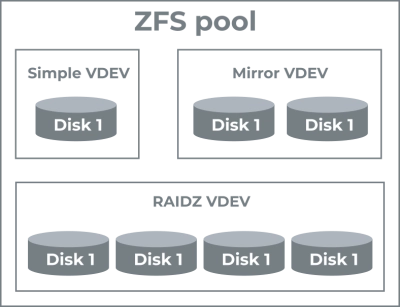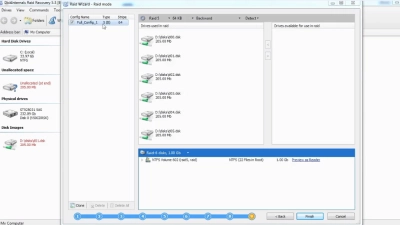ZFS RAID Expansion – Everything You Need to Know
As data storage needs grow, the ability to expand RAID configurations without compromising existing data becomes increasingly vital. ZFS, renowned for its reliability and advanced features, offers robust options for managing and scaling storage pools. However, while ZFS provides great flexibility, safely expanding a RAIDZ1 or other ZFS pool configuration requires careful planning and execution.
In this article, we’ll walk you through the essential steps and best practices for expanding ZFS pools, ensuring data integrity and system stability. Whether you're adding disks to accommodate greater capacity or optimizing performance, this guide is designed to help you navigate the complexities of ZFS RAID expansion with confidence.
Understanding ZFS RAID and Its Expansion Challenges
ZFS RAID is a sophisticated file system and volume manager that integrates file system capabilities with the redundancy and performance benefits of RAID technology. It supports various RAID configurations, such as RAIDZ, akin to traditional RAID 5 or RAID 6, but with enhanced data integrity achieved through copy-on-write and checksumming techniques. With ZFS, users can create pools that combine multiple disks into a unified storage system, promoting efficient disk space utilization and improved fault tolerance.
How ZFS Differs from Traditional RAID Systems
Unlike traditional RAID systems, ZFS integrates the file system and volume management layers, offering end-to-end data integrity. Traditional RAID controllers manage physical disks and present them as a single logical disk to the operating system, while ZFS manages both storage and file systems within the same architecture. This integration allows ZFS to continuously verify and correct data errors throughout the storage pool.
Additionally, ZFS employs a copy-on-write mechanism, meaning that any changes to data or metadata are written to new locations rather than overwriting existing data. This ensures that the file system remains consistent and free of corruption even in the event of system crashes or power failures. As a result, ZFS offers better protection against data loss and corruption compared to traditional RAID solutions.
Why Expansion is Complex in ZFS Compared to Other RAID Solutions
Expanding ZFS pools, particularly RAIDZ configurations, is a complex process due to the nature of how data and parity are distributed across disks. In a traditional RAID setup, adding disks often involves simply adding them to an existing array and restriping the data. However, in ZFS, the RAIDZ structure is more fixed, and expanding it requires either adding a new vdev (a collection of disks) to the pool or replacing each disk with larger ones, which can be time-consuming and limits flexibility.
Furthermore, ZFS pools are designed to work optimally when all disks in a vdev are of the same size, as each disk contributes equally to the overall performance and capacity of the pool. Adding disks of different sizes or expanding a pool without careful planning can lead to imbalances and reduced performance. Therefore, expanding ZFS RAIDZ pools requires strategic planning to maintain data integrity, performance, and optimal disk usage.
Can You Expand a ZFS RAID?
One of the key limitations of ZFS RAID, particularly RAIDZ configurations, lies in the complexity and rigidity of their structure. Unlike traditional RAID arrays, where disks can often be added to an existing array with minimal disruption, ZFS RAIDZ requires more careful management. Expansion typically involves either adding an entirely new vdev, which may not balance performance and capacity evenly, or replacing each disk in the existing vdev with a larger one—a process that can be both time-consuming and costly. Additionally, ZFS maintains data integrity by expecting uniformity in disk size within each vdev, making the mix-and-match approach less feasible.
Current State of RAIDZ Expansion in 2025
By 2025, the capability to expand RAIDZ pools has advanced significantly, with developments in OpenZFS and ongoing updates enhancing flexibility. ZFS now includes experimental features that permit the expansion of existing RAIDZ vdevs, allowing for more straightforward scalability without complete restructuring. This new capability—often referred to as "RAIDZ expansion" and "zfs expand raidz"—enables users to tactically add additional drives to a RAIDZ vdev while preserving the integrity and layout of the file system. These updates reflect a growing demand for more adaptable storage solutions and cater to both enterprise environments and individual users needing expanded capacity.
Community Discussions and OpenZFS Development Updates
The OpenZFS community remains a vibrant source of discussion and innovation, as developers and users collaborate to address challenges and refine the technology. Recent community discussions have focused on stability and practical implementation of RAIDZ expansion features, sharing user experiences, and best practices. In addition, OpenZFS development updates frequently highlight progress in expanding the feature set, showcasing enhancements designed to improve the performance and ease of expansion without compromising ZFS's core strengths in data protection and reliability.
ZFS Pool Expansion – Adding More Storage

Expanding a ZFS pool primarily involves adding additional vdevs, which are virtual devices comprising one or more physical disks. When expanding a ZFS pool, each vdev can be configured using different types of RAID setups, such as RAIDZ, mirror, or stripe. To increase the storage capacity of a ZFS pool, you can add more vdevs, which incorporate their allocated drives seamlessly into the pool. This approach allows you to scale your storage environment while respecting the architectural design of ZFS, which optimally manages data across all constituent vdevs.
When expanding a ZFS pool though new vdevs, it is important to consider the configuration of these new vdevs, as this impacts the overall redundancy, performance, and storage efficiency of the pool. Typically, it's advisable to maintain uniformity in the vdevs' configuration to prevent bottlenecks or imbalances in performance and capacity distribution.
Best Practices for Maintaining Redundancy and Performance
- 1. Uniform Vdev Configuration: Ensure that newly added vdevs have a similar configuration (e.g., disk count and type) as existing vdevs. This uniformity helps maintain balanced performance and efficient data distribution across the entire pool.
- 2. Maintain Redundancy Levels: Follow identical redundancy levels in all vdevs by maintaining consistent RAID configurations, such as RAIDZ2 or RAIDZ3, across the pool. This prevents weaknesses that might reduce fault tolerance and leaves your data better protected against disk failures.
- 3. Use High-Quality Drives: Choose reliable and high-performance drives, as the resilience and speed of the whole pool can only be as good as its weakest vdev or drive. Mixing drives from different manufacturers can add variability that's challenging to manage.
- 4. Monitor Disk Health and Performance: Regularly check the health of each drive in your pool. Employ ZFS's built-in scrubbing feature to detect and correct data errors and ensure your storage remains consistent and reliable.
- 5. Evaluate Risks Before Expansion: Understand if the addition of physical storage might disrupt operations. Plan expansions during periods of low usage to minimize impact on performance.
- 6. Plan for Future Growth: While immediate needs drive pool expansion, anticipate future requirements by incorporating some scalability in your expansion strategy. This foresight helps mitigate the need for disruptive changes later on.
RAIDZ Expansion – Current Methods and Workarounds
Manual Ways to Expand RAIDZ
Expanding a RAIDZ configuration manually has traditionally been a challenging task due to the nature of data distribution and the fixed structure of RAIDZ vdevs. One common method involves replacing existing drives with larger ones sequentially. Here's how this process typically works:
- 1. Replace Each Drive: Remove a drive from the RAIDZ vdev and replace it with a larger capacity drive.
- 2. Resilver the Data: After replacing a drive, the system will automatically begin to resilver, which involves copying and restructuring data onto the new drive.
- 3. Repeat for All Drives: Continue this process for each drive in the RAIDZ vdev until all have been upgraded.
- 4. Expand the vdev: Once every drive in the vdev has been replaced and resilvered, the pool will detect the additional space and allow you to expand.
This approach maintains data integrity throughout the expansion process but requires significant time and careful management to avoid potential data loss during drive replacement.
Using zfs replace and zfs attach for Expansion
The zfs replace and zfs attach commands are integral to managing ZFS pools, especially when expanding or upgrading storage:
zfs replace: Used for replacing a specific drive in a pool with a new one, often as part of upsizing drives in a RAIDZ expansion. This command helps facilitate the transition during drive upgrades by safely replacing drives while keeping the pool operational.zfs attach: Usually employed to convert a single-disk vdev into a mirrored vdev for added redundancy. While not directly applicable to RAIDZ, it highlights the flexibility ZFS offers for pool restructuring and enhancements.
By using these commands judiciously during the expansion process, administrators can ensure that data remains accessible and protected.
Risks and Trade-offs of Current Expansion Techniques
The current methods for expanding RAIDZ, while effective in certain scenarios, involve several risks and trade-offs:
- 1. Time-Consuming: The sequential nature of replacing and resilvering drives means the expansion process can take a considerable amount of time, particularly with large-capacity disks.
- 2. Risk of Data Loss: During the replacement phase, the pool is in a vulnerable state. If another drive fails during resilvering, it could result in data loss, especially if adequate redundancy isn't maintained.
- 3. Performance Impact: Resilvering is an intensive process that can significantly impact system performance, potentially affecting application operations during expansion.
- 4. Hardware Constraints: The need to replace each drive sequentially demands spare drive bays or temporary availability of additional hardware resources, which might not always be feasible.
- 5. Scalability Limits: While adding a completely new vdev is a viable workaround for expanding a pool, it might lead to imbalances in storage use and is limited by physical space and hardware specifications.
Ready to get your data back?

To start recovering data from RAID 0, RAID 1, 0+1, 1+0, 1E, RAID 4, RAID 5, 50, 5EE, 5R, RAID 6, RAID 60, RAIDZ, RAIDZ2, and JBOD, press the FREE DOWNLOAD button to get the latest version of DiskInternals RAID Recovery® and begin the step-by-step recovery process. You can preview all recovered files absolutely for free. To check the current prices, please press the Get Prices button. If you need any assistance, please feel free to contact Technical Support. The team is here to help you get your data back!
Future of ZFS Expansion – What’s Next?
The OpenZFS community continuously evolves, driven by an active development team and passionate contributors. On the roadmap, several key areas are anticipated to enhance the capabilities of ZFS expansion:
- Full RAIDZ vdev Expansion: Whereas RAIDZ expansion has historically been challenging, future improvements may offer more seamless ways to add drives to existing RAIDZ configurations without needing full vdev replacement. Efforts are underway to develop features that enable dynamic resizing and integration, focusing on minimizing performance disruptions and maintaining data integrity.
- Improved Resilvering Processes: Enhancements to make resilvering faster and less intrusive are a focal point. These improvements aim to reduce the impact on system performance during drive replacement and data reorganization.
- Enhanced Monitoring and Management Tools: New features and tools for better visualization and management of pool expansions are being developed. These are intended to give users greater control and insight into their systems, aiding strategic planning for future expansions.
- Integration with Cloud Services: As cloud storage becomes more prevalent, features that allow tighter integration with cloud platforms, or hybrid architectures, where parts of the ZFS pool span local and cloud resources, may become more widely adopted.
Should native RAIDZ expansion not fully meet users' immediate needs, several alternatives and strategies can help manage growing storage demands:
- Hybrid Storage Solutions: Implementing combinations of traditional ZFS setups with cloud-based storage can offer scalable capacity without needing significant changes to existing physical infrastructure.
- Striping Additional vdevs: While adding new vdevs to an existing pool, ensure they are evenly configured and integrated to avoid performance bottlenecks. This requires careful planning and monitoring to maintain overall pool efficiency.
- Data Reorganization and Optimization: Evaluating current data usage and reorganizing data across pools or cold storage can help optimize existing resources. Regular audits can identify under-utilized data that can be archived or moved to less demanding storage solutions.
- Custom Scripting and Automation: For environments with specific needs, custom scripting solutions that automate regular maintenance and monitoring tasks can help streamline the expansion process and maintain system health.
- Leveraging Third-Party Tools: Exploring third-party ZFS management tools can provide added functionality and user interfaces that might simplify management and expansion tasks.
ZFS Recovery Considerations During Expansion
ZFS RAID expansion, while essential for accommodating growing storage needs, inherently carries certain risks that could potentially jeopardize data integrity:
- Drive Failures During Resilvering: During the expansion process, especially when replacing drives one at a time, the system is vulnerable to failures. A drive failure during this phase can expose the pool to data loss risks, especially if redundancy levels are compromised.
- Human Error: Mistakes in executing commands or misconfigurations during expansion can lead to data problems. Accidental removal of the wrong drive or disruptions can cause significant issues.
- Resilvering Performance: Resilvering processes, which can be resource-intensive, might lead to performance degradation. Any system instability during these tasks can exacerbate the risk of data corruption.
To mitigate data loss risks, adhering to the following best practices can safeguard your data before expanding your ZFS pool:
- Comprehensive Backups: Ensure all critical data is backed up before undertaking an expansion. Utilize off-site or cloud-based backups to protect against local hardware failures.
- Testing Procedures: Before executing changes, simulate the expansion process in a test environment. This helps identify potential pitfalls and allows you to plan remediation steps in case of issues.
- Upgrade Redundancy Levels: If possible, enhance redundancy before starting the expansion. This could involve temporarily converting single vdevs into mirror configurations, if feasible.
- Check for Errors and Health: Use ZFS tools to scrub and check the pool for existing errors. Resolve any issues before starting the expansion to reduce vulnerability during the process.
- Schedule During Low-Activity Periods: Conduct expansions during times of minimal system use to lessen performance impact and ensure operations do not interfere with critical business functions.
Using DiskInternals RAID Recovery™ for Recovering Lost ZFS Data
DiskInternals RAID Recovery™ is a tool designed to help recover data from RAID systems, including ZFS RAID configurations. If data loss occurs during an expansion process, DiskInternals RAID Recovery™ can be invaluable:
- Automated Analysis: The software analyzes the RAID structure, recognizing and configuring itself to rebuild logical array formations for data extraction.
- Comprehensive Recovery: It supports a wide range of RAID levels and can recover data from damaged or incomplete RAID arrays.

- User-Friendly Interface: Its intuitive interface guides users through the recovery process, making it accessible even to those with limited technical expertise.
- Non-Destructive Recovery: The tool operates in a read-only mode on your drives, ensuring that original data remains intact throughout the recovery attempt.
Step-by-Step Guide: How to Expand ZFS Storage
Preparing Your System
- 1. Backup Your Data: Before starting the expansion process, create a complete backup of all important data. Ensure that backups are stored in a secure, off-site location if possible.
- 2. Check Current Pool Status: Use the
zpool statuscommand to check the health of the existing pool. Resolve any errors or issues identified by the system to ensure a stable foundation for expansion.
zpool status
- 3. Plan the Expansion: Decide on the configuration for the new vdevs. Ensure that the new vdevs maintain uniformity with the existing pool setup in terms of RAID configuration and performance expectations.
- 4. Acquire Hardware: Procure the additional disks required for the expansion. Make sure they are compatible with your existing hardware and ZFS configuration. Use similar or same capacity and performance characteristics to maintain balance.
- 5. Schedule Downtime (if needed): Determine an optimal time for the expansion with minimal impact on users, ideally during low-activity periods.
Adding New Disks to an Existing ZFS Pool
- 1. Install New Disks: Physically install the new disks into your server or storage appliance. Ensure they are powered and recognized by the system.
- 2. Identify New Disks: Use tools like
lsblkorfdiskto identify the newly installed disks. Verify that these disks are not currently part of any existing filesystem or used elsewhere.
lsblk
- 3. Add the New vdev to the Pool: Use the
zpool addcommand to add the new disks as a vdev to the existing pool. Ensure you choose the right RAID configuration at this stage.
For example, adding a new RAIDZ vdev might look like this:
zpool add poolname raidz /dev/sdX /dev/sdY /dev/sdZ
Replace /dev/sdX, /dev/sdY, /dev/sdZ with the appropriate device names for your setup.
- 4. Monitor Resilvering (if applicable): If adding redundant vdevs leads to resilvering, monitor the process to ensure stability. Use
zpool statusto check the progress regularly.
Verifying Expansion Success
- 1. Verify Pool Capacity: After adding the new vdev, confirm the increased capacity in the pool using the
zpool listcommand.
zpool list
- 2. Check Data Integrity: Run a ZFS scrub to verify data integrity across the newly expanded pool. This identifies and corrects any data anomalies that might have been introduced during the expansion.
zpool scrub poolname
- 3. Verify System Performance: Monitor system performance to ensure that the changes have not introduced bottlenecks or unexpected behavior. Check that read/write speeds are consistent with expectations.
- 4. Document Changes: Maintain documentation of the expansion procedure, including hardware changes and any configurations for future reference and troubleshooting.
| Aspect | ZFS Expansion | Traditional RAID Expansion |
| Ease of Expansion | Complex; requires adding new vdevs or replacing all drives one by one | Generally easier; can often add drives directly to existing arrays |
| Redundancy Impact | Requires careful planning; possible temporary reduction during drive replacement | Typically maintains existing redundancy |
| Required Downtime | Minimal with good planning; possible performance impact during resilvering | Varies; may need downtime for array reconfiguration |
| Scalability | Limited by vdev configuration; less flexible | More flexible; can dynamically expand in some cases |
| Performance Impact | Possible performance degradation during expansion due to resilvering and disk balancing | Varies; may require restriping but less intensive than resilvering |
| Data Integrity | Strong; end-to-end checksumming and data integrity features | Good but dependent on hardware and configuration |
Tip: Learn more on ZFS vs RAID here!
Conclusion – Is ZFS Expansion Worth It?
Expanding ZFS storage offers a nuanced approach to scaling your storage infrastructure, balancing robust data integrity with some degree of complexity. Here are the key takeaways:
- Complexity vs. Flexibility: ZFS expansion offers flexibility through vdev additions but requires careful planning and understanding of the system’s architecture. While not as straightforward as traditional RAID, its expansion process allows for robust data protection features.
- Enhanced Data Integrity: ZFS's end-to-end checksumming and copy-on-write mechanisms make it an excellent choice for environments where data integrity is paramount.
- Performance Implications: The resilvering process and resource demands during expansion can impact performance. Proper scheduling and system monitoring are essential to minimize disruptions.
- Scalability and Redundancy: While scalable, expansion is best suited for evenly matched and planned growth strategies to maintain optimal performance and redundancy.
Deciding between expanding an existing ZFS pool or creating a new one depends on several factors:
- System Requirements and Growth: If your existing pool’s configuration can support the anticipated storage growth without significant performance loss or complexity, expansion might be the right choice. However, if expected growth could imbalance the current setup, starting a new pool could offer a more organized approach to managing storage.
- Redundancy Needs: Expansion is advisable when redundancy configurations align well with organizational policies and do not compromise data safety.
- Hardware and Infrastructure: Availability of additional hardware resources can dictate whether expansion is feasible or if setting up an entirely new pool is more practical.
- Operational Downtime and Impact: If minimizing downtime and maintaining steady performance are priorities, plan expansions during low-usage times or consider adding new pools to distribute loads effectively.
Ultimately, ZFS expansion is worth considering for environments prioritizing data integrity and flexibility, provided the planning addresses potential complexities and risks. Creating a new pool may be more optimal for significantly differing capacity needs or when existing pool architectures do not support efficient scaling. Through strategic assessment of your needs and careful planning, ZFS can effectively support your evolving storage landscape.
